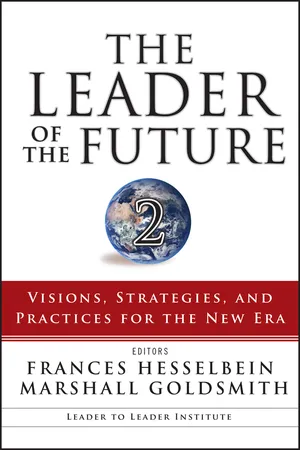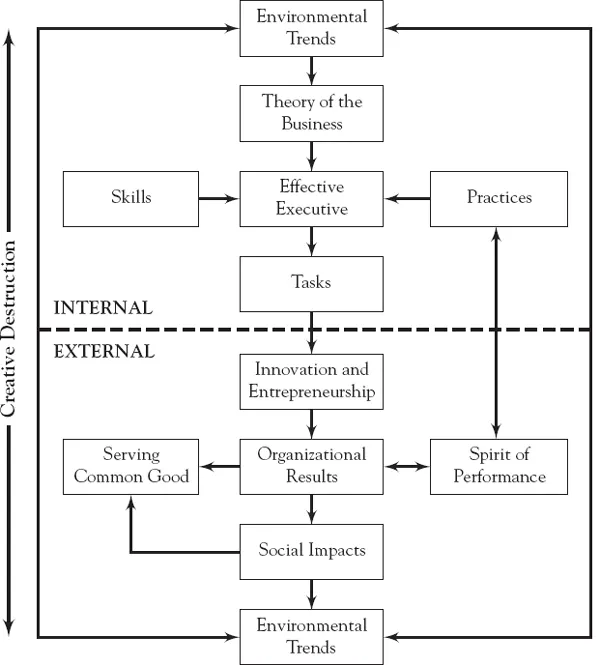
The Leader of the Future 2
Visions, Strategies, and Practices for the New Era
- English
- ePUB (mobile friendly)
- Available on iOS & Android
The Leader of the Future 2
Visions, Strategies, and Practices for the New Era
About this book
The Leader of the Future 2 follows in the footsteps of the international bestseller The Leader of the Future, which has been translated into twenty-eight languages, and is one of the most widely distributed edited collections on leadership to date.
In twenty-seven inspiring and insightful essays, this book celebrates the wisdom of some of the most recognized thought leaders of our day who share their unique vision of leadership for the future.
Returning Contributors: Ken Blanchard with Dennis Carey, Stephen Covey, Marshall Goldsmith, Charles Handy, Sally Helgesen, Rosabeth Moss Kanter, Jim Kouzes & Barry Posner, Richard Leider, Ed Schein, Peter Senge, and Dave Ulrich with Norm Smallwood. New Contributors: John Alexander, Darlyne Bailey, Howard Gardner with Lynn Barendsen, Usman Ghani, Ronald Heifetz, Joe Maciariello, Jan Masaoka, John Mroz, Brian O'Connell, Jeff Pfeffer, Ponchitta Pierce, Srikumar Rao, General Eric Shinseki, R. Roosevelt Thomas, Noel Tichy with Chris DeRose, and Tom Tierney.
"Hesselbein and Marshall Goldsmith, one of the USA's top executive coaches, edited the collection The Leader of the Future 2. Its 27 eloquent essays provide a kind of hopeful, idealistic best-case scenario for future leaders of non-profits and businesses. This is not a cookie-cutter, how-to approach. The job of the essayists is to provide food for thought and goals. The high quality of writing here should inspire anyone who has aspirations for leadership."
—Bruce Rosenstein, USA Today
Frequently asked questions
- Essential is ideal for learners and professionals who enjoy exploring a wide range of subjects. Access the Essential Library with 800,000+ trusted titles and best-sellers across business, personal growth, and the humanities. Includes unlimited reading time and Standard Read Aloud voice.
- Complete: Perfect for advanced learners and researchers needing full, unrestricted access. Unlock 1.4M+ books across hundreds of subjects, including academic and specialized titles. The Complete Plan also includes advanced features like Premium Read Aloud and Research Assistant.
Please note we cannot support devices running on iOS 13 and Android 7 or earlier. Learn more about using the app.
Information
Part I
A Vision of Leadership
1
Peter F. Drucker on Executive Leadership and Effectiveness
Joseph A. Maciariello is Horton Professor of Management at the Peter F. Drucker and Masatoshi Ito Graduate School of Management at Claremont Graduate University. He has collaborated with Peter Drucker to publish The Daily Drucker (HarperCollins, 2004), The Effective Executive in Action (HarperCollins, 2005), three Internet executive development modules titled Leading Change (Corpedia Education, 2003, 2004), and two articles on management in the social sector. In addition he has written three articles providing a systematic, integrated description of some of the major works of Peter Drucker—“Peter F. Drucker on a Functioning Society” (Leader to Leader, Summer 2005), “Mastering Peter Drucker’s The Effective Executive” (Leader to Leader, Summer 2006), and this current article. He teaches the course “Drucker on Management” for M.B.A. and Executive M.B.A. students and is working on The Peter F. Drucker Curriculum Project for use at the Drucker-Ito School and at universities throughout the world.

Executive Leadership and Effectiveness
- Exhibit high levels of integrity in their moral and ethical conduct
- Focus on results
- Build on strengths—one’s own and others’
- Lead beyond borders to meet at least minimum requirements of all stakeholders, including customers, shareholders, and the public, thereby serving the common good
The Spirit of Performance: True Test of an Organization
the lifting of a person’s vision to higher sights, the raising of a person’s performance to a higher standard, and the building of a person’s personality beyond its normal limitations.3
The Theory of the Business
- What is our mission?
- What are our core competencies?
- Who are our customers and noncustomers?
- What do we consider results for the enterprise?
- What should our theory be? (Which in turn focuses executives to look for opportunities for innovation.)
Table of contents
- Cover
- Contents
- Title page
- Copyright
- Preface
- Part I: A Vision of Leadership
- Part II: Leading in a Diverse World
- Part III: Leading in a Time of Crisis and Complexity
- Part IV: Leading Organizations of the Future
- Part V: The Quality and Character of the Leader of the Future
- The Editors
- Index
- End User License Agreement